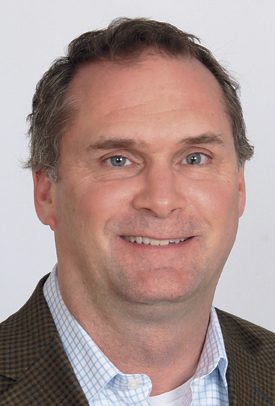Specialty Lines Markets
PROFESSIONAL LIABILITY INSURANCE
Market hardens as carriers reduce capacity and limits
By Joseph S. Harrington, CPCU
When times get tough, you discover who really has your back. Well, times are tough for professionals seeking professional liability insurance.
That includes insurance agents and brokers, who have seen carriers they relied on for protection head to the exits, according to the 2021 Management and Professional Liability Market Outlook study, published by Risk Placement Services (RPS).
“There are still concerns over frequency and severity of claims, as well as social inflation [in the healthcare sector], … but that doesn’t mean premium decreases are on the horizon.”
—James McNitt
Area President, Healthcare Practice
Risk Placement Services
In the report, RPS says the recent surge in natural disasters led to a corresponding surge in claims that were not covered or underinsured, which in turn has prompted an increase in errors and omissions (E&O) claims against insurance agents and brokers.
That experience, plus the specter of claims that producers failed to prepare clients for the pandemic, has “led to many carriers exiting this market segment, which has definitely led to harder market conditions.”

You’re not alone
If it’s of any consolation, RPS makes it clear that agents and brokers are hardly alone. “Nearly every line of business in the market is firming in terms of rate increases, changes in retention, capacity, and terms and conditions,” says Manny Cho, RPS’s executive vice president for executive lines.
Among the markets studied by RPS, allied healthcare is reportedly seeing primary rate increases averaging about 15%, with excess premiums growing from 50% of primary premium to 75% or 80%.

“There are still concerns over frequency and severity of claims, as well as social inflation” in the health-care sector, says James McNitt, RPS’s area president for its healthcare practice. “Rate increases are expected to plateau in the next few years,” he says, “but that doesn’t mean premium decreases are on the horizon.”
Rate changes are relatively flat in admitted markets for lawyers professional liability insurance, but carriers are reducing capacity, especially for firms of 10 or fewer attorneys, which comprise most U.S. law firms. Things are looking better for mid-sized firms, says Ron Kiefer, RPS’s senior vice president for executive lines, thanks to new market entrants targeting that segment, providing additional capacity and more competitive pricing.

Even before the tragic collapse of a residential structure in Surfside, Florida, the market for architects and engineers (A&E) liability insurance was splitting into two segments, according to RPS.
One segment consisted of “highly desirable, low-to-moderate-hazard accounts” with ample capacity available at reasonable terms, according to the RPS report. Outside of that segment, capacity is decreasing for accounts providing services that underwriters find concerning, including certain structural work and residential apartment and condominium complexes. Even firms with good loss experience in that category struggle to find affordable coverage.

Regarding coverage for building contractors, John Lanni, RPS’s area vice president for executive lines, finds carriers to be tightening capacity. “If an insured needs $10 million or more in coverage, they will need to enter the market early to find that capacity,” he says. “That may require more carriers on the policy than in previous years.”
Small business stress
Cho’s observations are shared by John Burkhart, president of specialty lines at Skyward Specialty Insurance. “We are seeing double-digit rate in-creases throughout the E&O market,” Burkhart says. “We also see some larger carriers reducing the capacity being deployed, and we rarely see large limits.”
Small operations are seeing the biggest challenges, Burkhart observes.

“Small businesses’ top line growth saw negative impact [from the pandemic], resulting in significant cost cutting,” he says. “We’ve seen small accounts seek premium relief on renewals or look to reduce [coverage] to meet their needs.” Burkhart adds that, since the start of the pandemic, small businesses have been shifting their insurance buying from in-person to online transactions, a development he considers critical for companies serving that market.
As for the effect of the pandemic on E&O accounts, Burkhart detects only minimal impact so far, but he foresees new opportunities arising from the economic recovery.
“One profession where we see a potential impact is the real estate sector, with property managers,” he says. “As health and safety guidelines change, property managers are [responsible] to secure and keep their properties safe with upgrades.”
In light of that, Burkhart says that Skyward Specialty is modeling the impact of different disease and regulatory scenarios on its property management portfolio while also assessing the likely impact of lifting eviction moratoriums.
“The ability of experienced front-line underwriters to use their knowledge of similar risks to assess and price on the spot is a clear delineator of who will win the business, especially when the timeliness of the transaction is a factor.”
—John Burkhart
President, Specialty Lines
Skyward Specialty Insurance
Opportunities
Better times lie ahead as our society and economy recover from the pandemic, which has created some new opportunities for professionals and those who insure them.
That’s certainly the case for Prime Insurance Company, a commercial specialty lines carrier. Prime has enjoyed substantial premium growth in 2021 while maintaining strong loss ratios, says Barbara Malkowski, senior vice president.
According to Malkowski, Prime, which prides itself in never having cancelled a class of business, is picking up business other carriers are avoiding or abandoning, including general, professional, and management liability coverage for communicable diseases on a primary and/or excess basis.
Prime is also expanding its professional liability business to include emerging occupational risks. Among the emerging new classes is individual liability for law enforcement officers. Demand for such coverage is surging as municipalities and police face growing legal scrutiny over police conduct. In addition, Prime is seeing increased interest in professional liability coverage from houses of worship, as cases of sexual abuse involving clergy have led to growing scrutiny of clergy misconduct in general.
“If an account is a good fit, we’ll write it,” says Malkowski. “We’re an opportunistic carrier.”
Skyward Specialty also sees new business opportunities emerging from the pandemic. “The pandemic has provided new business opportunities,” says Burkhart. “These range from virtual and at-home fitness and meal services to companies fulfilling the need for stricter cleanliness standards.
“Technology has enabled remote work to occur almost seamlessly, making it easier for people to be their own boss,” he adds. “As a result, we are seeing an increase in consulting. People are taking their years of experience in a certain field and going out on their own to use that knowledge to assist others.”
To capitalize on these new opportunities, Burkhart emphasizes the importance of experienced underwriters making quick decisions at the point of sale.
“The ability of experienced front-line underwriters to use their knowledge of similar risks to assess and price on the spot is a clear delineator of who will win the business, especially when the timeliness of the transaction is a factor,” he says.
“There is a real opportunity for agents, brokers, carriers and their wholesalers to help with risk management in a way that we have not been able to in the past.”
—Manny Cho
Executive Vice President, Executive Lines
Risk Placement Services
“As the market adapts to the new normal,” he adds, “experienced underwriters and brokers with long-standing relationships are able to use them to secure the most beneficial deals.”
Risk management
For Cho, the provision of risk management services will be key to success in the professional liability market.
“There is a real opportunity for agents, brokers, carriers and their wholesalers to help with risk management in a way that we have not been able to in the past,” he says. “As the country reopens and companies establish return-to-work procedures, it will be challenging for firms to manage remote and hybrid work environments, mask mandates, and social distancing measures in different states and counties.
“Carriers can provide risk management tools to help firms—especially in the SME space—navigate these complex issues,” he concludes.
For more information:
Prime Insurance Company
www.primeis.com
Risk Placement Services
www.rpsins.com
Skyward Specialty Insurance
www.skywardinsurance.com
The author
Joseph S. Harrington, CPCU, is an independent business writer specializing in property and casualty insurance coverages and operations. For 21 years, Joe was the communications director for the American Association of Insurance Services (AAIS), a P-C advisory organization. Prior to that, Joe worked in journalism and as a reporter and editor in financial services.





